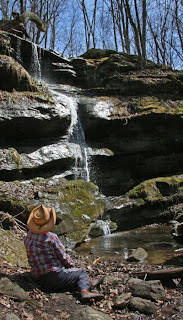 HEMLOCK FALLS--
HEMLOCK FALLS--
Crisp Spring air tickled the tall pines under a sapphire sky as we hiked the tributary upstream toward Hemlock Falls, just east of Bunkerhill North Road.
In the “History of Richland County, 1880” the falls area we were approaching was described as, “...without a doubt the most interesting geographical feature in the county.”
Geologic study indicates the sandstone cliffs at the falls were born in the sediments at the edge of a great ocean delta—perhaps 350 million years ago. The cliffs were sculpted by more recent Pleistocene glaciations—about the time mankind first walked on earth.
More recent history indicates Indians and early European settlers knew the area well. An early Indian village known as Helltown was located nearby as was Newville; once one of the largest towns in the county.
Both of those town sites disappeared when Pleasant Hill Lake was formed.
The first non-Indian owner of the site was an Ashland area doctor. Later it came into the ownership of the Commodore Johnston family; the heirs of which sold the site to the Mohican School in the Out-of-Doors in 1999.
I had visited the falls over the years but was surprised to learn on this day, there are two falls at the site. Upstream of the falls the Hemlock Run tributary splits and one of the streams falls about 60 feet while its companion cascades about 100 feet down the sandstone formation.

The stream is tributary to the Clear Fork branch of the Mohican River which flows into Pleasant Hill Lake and ultimately to the Ohio River and the Gulf of Mexico.
Majestic Hemlock trees abound around the site, hence the name. Huge slump blocks of stone have separated from the rock walls by weathering and toppled into the stream bed far below. One of those slump rocks is thought to be the largest in Ohio.
In the top photo Jane Jako of Mansfield and her companion from Yellow Springs, OH bask in afternoon sunlight on a ledge about midway down the larger of the two falls.
In the lower photo my ladyfriend Joetta Goodman enjoys the close-up view of the 60 foot cascade.
Steve McKee, director of the Gorman Nature Center in Mansfield, once surveyed the site and found several species of plants on Ohio’s endangered list. Over half of the 31 species of ferns found in Richland County are found at the falls site.
The site enjoys being protected as a conservation area by the outdoor school and a Mansfield church which owns adjoining property.
A visit to this natural jewel must be respected for the delightful privilege it is.

 fitness class at the Mansfield Y under the tutelage of veteran teacher Shirley Weddell. In the small photo they share a giggle at some coordination that went astray.
fitness class at the Mansfield Y under the tutelage of veteran teacher Shirley Weddell. In the small photo they share a giggle at some coordination that went astray. fitness class at the Mansfield Y under the tutelage of veteran teacher Shirley Weddell. In the small photo they share a giggle at some coordination that went astray.
fitness class at the Mansfield Y under the tutelage of veteran teacher Shirley Weddell. In the small photo they share a giggle at some coordination that went astray.























